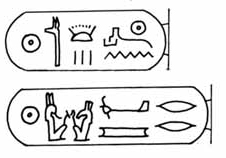Setnakht (Userkhaura Meryamun) - ruled 1186-1184 bc

Al Ahram Weekly (11 - 17 January 2007, Issue No. 827) reports:
A quartz stela unearthed in the Avenue of Ram-headed Sphinxes in Luxor
has changed what we know of the 20th dynasty
The new information not only illustrates the growing power of the
priesthood during the New Kingdom, but also changes some concepts of the
20th dynasty, especially the facts and figures relating to its founder,
the Pharaoh Sethnakht.
The stela is a quartzite religious relief engraved in two parts; the
upper one featuring Sethnakht wearing the blue crown and kneeling before
the god Amun- Re, who holds the key of life in his right hand and the
waset symbol in his left hand. The pharaoh is offering the god the
feather of justice, while the goddess Mut, standing in the background,
raises her left hand as a symbol of protection and holds the key of life
in her right. The lower part bears 17 lines of hieroglyphic text
followed by a scene showing Bakenkhunsu, the High Priest of Amun-Re,
wearing his religious robes and praying.
Ever since the discovery several years ago of his four limestone
statues, now exhibited at the Egyptian Museum, nothing was known about
Bakenkhunsu except for his title as the High Priest of Amun-Re. Now,
Hawass says, after deciphering the hieroglyphic text, the priest's
family members and relatives have been identified. The priest's
construction achievements at Karnak Temple's Great Hall can also be
recognised. The text mentions that Bakenkhunsu carried out and oversaw
several construction projects at the Great Hall.
Early studies on the stela revealed that it was a very well-preserved Ancient
Egyptian object carved for Bakenkhunsu during the fourth year of
Setnakht's reign. It was made to be installed in the Temple of Amun-Re
at Karnak. This date contradicts with the accepted record, which says
Sethnakht ruled Egypt for only three years. According to the new
information provided by the stela, Setnakht's reign certainly lasted
for four years, and may have continued for longer. Hence, early
constructions at the Temple of Amun-Re in Karnak could be attributed to
Sethnakht and completed by his son and successor Ramesses III, who also
built a mortuary temple at Medinet Habu on Luxor's west bank.
The stela is now being subjected to comprehensive studies in an attempt
to reveal more of the 20th dynasty's secrets and, according to what may
be discovered, to rewrite its history.
The stela was found accidentally by an Egyptian excavation team working
on a project to reconstruct the ram-headed sphinx avenue in Luxor.
Although the 20th dynasty was founded by Setnakhte, its most important
member was Ramesses III, who modelled his career after the great pharaoh
of the previous dynasty, Ramesses II. The 20th is considered to be the
last dynasty of the New Kingdom of Egypt, and was followed by the Third
Intermediate Period.
The era of these rulers is notable for the beginning of the systematic
robbing of royal tombs. Many surviving administrative documents from
this period are records of investigations and punishment for these
crimes, especially in the reigns of Ramesses IX and Ramesses XI.
Unfortunately the bickering between the royal heirs that had been a
feature the 19th dynasty continued in the 20th, with the winner being
the strongest. This group of heirs was described by Diodorus Siculus as
"confirmed sluggards devoted only to indulgence and luxury," without
"any deed worthy of historical note". However, at this time Egypt was
increasingly beset by a series of droughts, below- normal flood levels
of the Nile, famine, civil unrest and official corruption -- all of
which would limit the managerial abilities of any king. The power of the
last pharaoh, Ramesses XI, grew so weak that in the south the High
Priests of Amun at Thebes became the de facto rulers of Upper Egypt,
while Smendes controlled Lower Egypt even before Ramesses XI's death.
Smendes went on to found the 21st dynasty at Tanis.